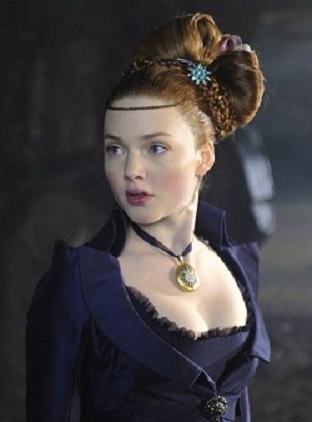Headbands have been around for a long time. I mean, a really long time. Think Greek, circa 400 BC.

Handsome dude sporting laurel wreath
In Ancient Greece the laurel wreath was placed on the heads of victors of athletic competitions like the Olympics, and eventually came to be a status symbol as the Romans took the wreath and ran with it. Poets, distinguished military men, and emperors all used wreaths as a way to let everyone else know how accomplished, valiant, and divine they were.
Today we’re going to be covering one specific type of headband that came, disappeared, and briefly flickered back into fashion almost 400 years after its first appearance.
The ferronnière (also spelled ferronière, or without those weird French accents) was a headband that first emerged in Italy in the 15th century, though no one is sure if it was called a ferronnière at the time or if that name came later. It’s made up of a delicate chain or piece of fabric worn across the forehead, usually with an ornament or pendant attached to the center.
Most accounts claim the ferronnière took its name from the famous portrait, La Belle Ferronnière, painted by none other than Leonardo da Vinci circa 1495 (or at least we think it’s by Leonardo–again, no one knows for sure). The true identity of the woman in the portrait is a subject for debate among art historians, since we can’t exactly email Leonardo with a polite request for clarification.

Chicken or the egg? Did the headband take her name or did she get the name because of the headband? Everyone pretends they know, but nobody really knows. That’s history for you.
At one point the lady was believed to be the wife of a French dude named Le Ferron. His name was turned into the French word for ironworker (ferronnier) and then feminized to ferronnière, which meant “wife/daughter of an ironworker.” Makes sense, except why not just call her by her actual name, instead of sort of alluding to her husband?
Well, apparently Le Ferron and his wife had some marital issues, because everyone knew she was actually seeing King Francis I on the side. Being the king’s mistress would explain the commission of her portrait, and would also explain why they didn’t just slap her actual last name on the painting. Everyone can know you’re fooling around with the king, but no one can tag you in his Facebook photos.
(Incidentally, if you ask the right historians then there’s a juicy revenge story involving syphilis to go along with this love triangle. But back to fashion.)
Merriam-Webster tells us the first known use of the word ferronnière as a headpiece wasn’t until 1831, around the same time a bunch of Victorian hipsters brought it back because it was “so Renaissance,” and they were all about that Classical vibe. For about fifteen years or so the ferronnière was a fashionable accessory for both day and evening wear, though more often for evening.
Charles Dickens’ novel Great Expectations took place during this exact period of the Victorian era, and the 2012 movie version made good on the chance to utilize this unique piece of jewelry. Here’s a shot of the lovely Holliday Grainger as Estella wearing a ferronnière, braided out of what appears to be a lock of her own hair.

She’s missing the usual dangly jewel, but the rest of her hairstyle is so detailed and stunning that we’ll forgive her.
I’m in love with this entire costume, of course, but Estella’s hairstyles in this movie are on point. This costume was the first thing that came to mind when deciding what piece to blog about.
The ferronnière eventually went out of vogue again as changes in hairstyles could no longer accommodate it, but you might see references to it in Rennaissance period works, Victorian period works, or even in stylized fantasy works (think of Arwen’s fancy, delicate elf crown with the teardrop pearl at the end of Return of the King).


